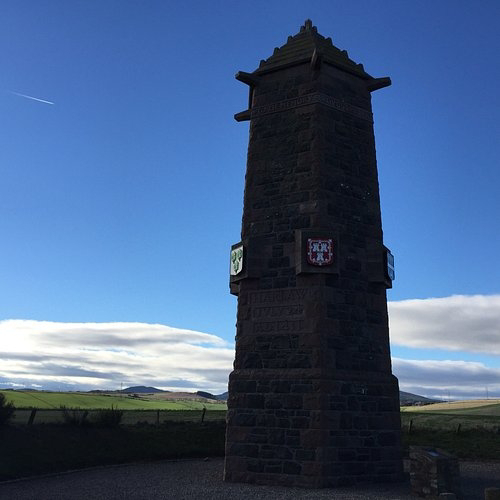The Battle of Harlaw
Battle of Harlaw monument near the Chapel of Garioch.
The Battle of Harlaw
The poem describes a medieval conflict between armies of lowlanders and highlanders on July 24, 1411 near Inverurie, Aberdeenshire. The author is unknown although there is a reference to a work called The Battle of Harlaw within The Complaint of Scotland, c.1549, unfortunately the lyrics are lost. Sir Walter Scott mentions a ballad called Harlaw in his 1816 novel The Antiquary. It is believed the poem in its present form has been circulating from around 100 to 150 years. James Francis Child collected 305 ballads which included the Battle of Harlaw. This version was published in the Child Ballads (1860). James Maidman writes about a version he knew in his book, Scottish Ballads and Songs, Historical and Traditionary, (1868). W. Patterson, pp. 198–200. The first audio recording was in 1953 by Jennie Robertson.
The Battle of Harlaw
As I cam’ by the Garioch land,
An’ doun by Netherha’,
There were fifty thoosan’ Hielan’men,
A-marchin’ tae Harlaw.
Chorus (after each verse):
Singing didde-aye-O,
Sing fa-la-doh,
Sing diddle-aye-O-aye-ay.
“It’s did ye come fae the Hielan’s, men,
An’ did ye come a’ the way?
An’ did ye see MacDonal’ an’ his men
As they marched fae Skye?”
“It’s I cam’ fae the Hielan’s, men,
An’ I cam a’ the way?
An’ I saw MacDonal’ an’ his men
As they marched fae Skye.”
“It’s wis ye near or near enough,
Did ye their number see?
Come tell tae me, John Hielan’ man,
What might their number be?”
“For I wis near or near enough,
An’ I their number sa’;
There were fifty thoosand Hielan’men
A-marching tae Harlaw.”
For they went on an’ furder on,
An’ doun in by Balquhain;
It’s there they met Sir James the Rose,
Wi’ him Sir John the Grame.
“If that be true,” said Sir James the Rose,
“We’ll no’ come muckle speed;
We will caal upon wir merry men,
An’ we’ll turn wir horses’ heid.”
“O nay, O nay,” said John the Grame,
“Sic things we mauna dee;
For the gallant Grames were never bate,
And we’ll try fit they can dee.”
They went on an’ furder on,
An’ doun in by Harlaw;
They fell full close on ilka side,
Sic strikes ye never sa’.
They fell full close on ilka side,
Sic strikes ye never sa’;
For ilka sword gaed clash for clash
At the Battle o’ Harlaw.
The Hielan’men wi’ their lang swords,
They laid on us full sair;
The’ drove back wir merry men,
Three acres breadth an’ mair.
Lord Forbes to his brother did say,
“O brither dinna ye see?
The’ beat us back on every side,
An’ we’ll be forced to flee.”
“O nay, O nay, my brother dear,
O nay, that mauna be;
For you’ll tak’ your guid sword in your hand,
An’ ye’ll gang in wi’ me.”
For the’ two brithers brave,
Went in amangst the thrang;
They swope doun the Hielan’men,
Wi swords baith sharp an’ lang.
The first stike Lord Forbes gied,
The brave Lord Donal’ reeles;
The second strike Lord Forbes gied,
The brave MacDonal’ fell.
What a cry amongst the Hielan’men,
When they see’d their leader fa’;
They lifted him an’ buried him
A lang mile fae Harlaw.
History of the conflict
Before being united as a country, the various regions of Scotland were divided by centuries of bitter rivalry between the different ethnic groups and kingdoms.
The western seaboard of the country influenced by Gaelic-Viking culture owed allegiance to the Lord of the Isles, whilst the northeast region traditionally formed part of the ancient Pictish Kingdom. Safe to say then that the clans of the west coast did not always see eye-to-eye with those of the northeast.
The latest feud concerned Donald, Lord of the Isles, who having fought for control of Ross, a large region of northern Scotland, now planned to strike south east into Moray towards Aberdeen, along with 10,000 of his clansmen.
Forewarned of Donald’s advance, Alexander Stewart, Earl of Mar hastily assembled a force from the local clans including the Irvings, Lesleys, Lovels, Maules, Morays and Stirlings. Mar’s force is said to have numbered only around 1,500 men, although in reality it is likely to have been much larger, including a substantial numbers of well-equipped mounted knights.
Holding his knights as cavalry reserve, Mar organised his spearmen into battle formation to face the advancing islanders near the town of Inverurie, on the morning of 24th July 1411.
By nightfall the dead littered the field. Exhausted, Mar and the survivors of his army rested and waited for the battle to resume the following morning. With the dawn they found that Donald had left the field, retreating back to the Isles.
The heavy losses suffered by both sides meant that neither side could claim the day; however Mar had successfully defended Aberdeen.





Comments
Post a Comment